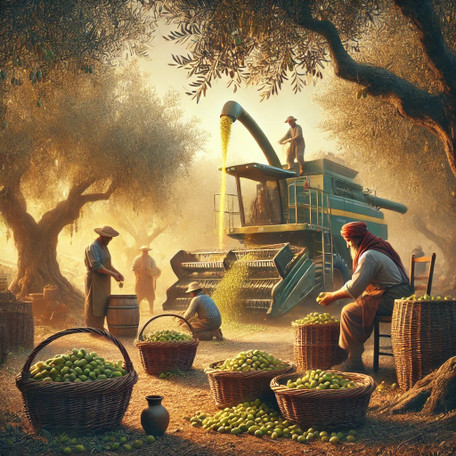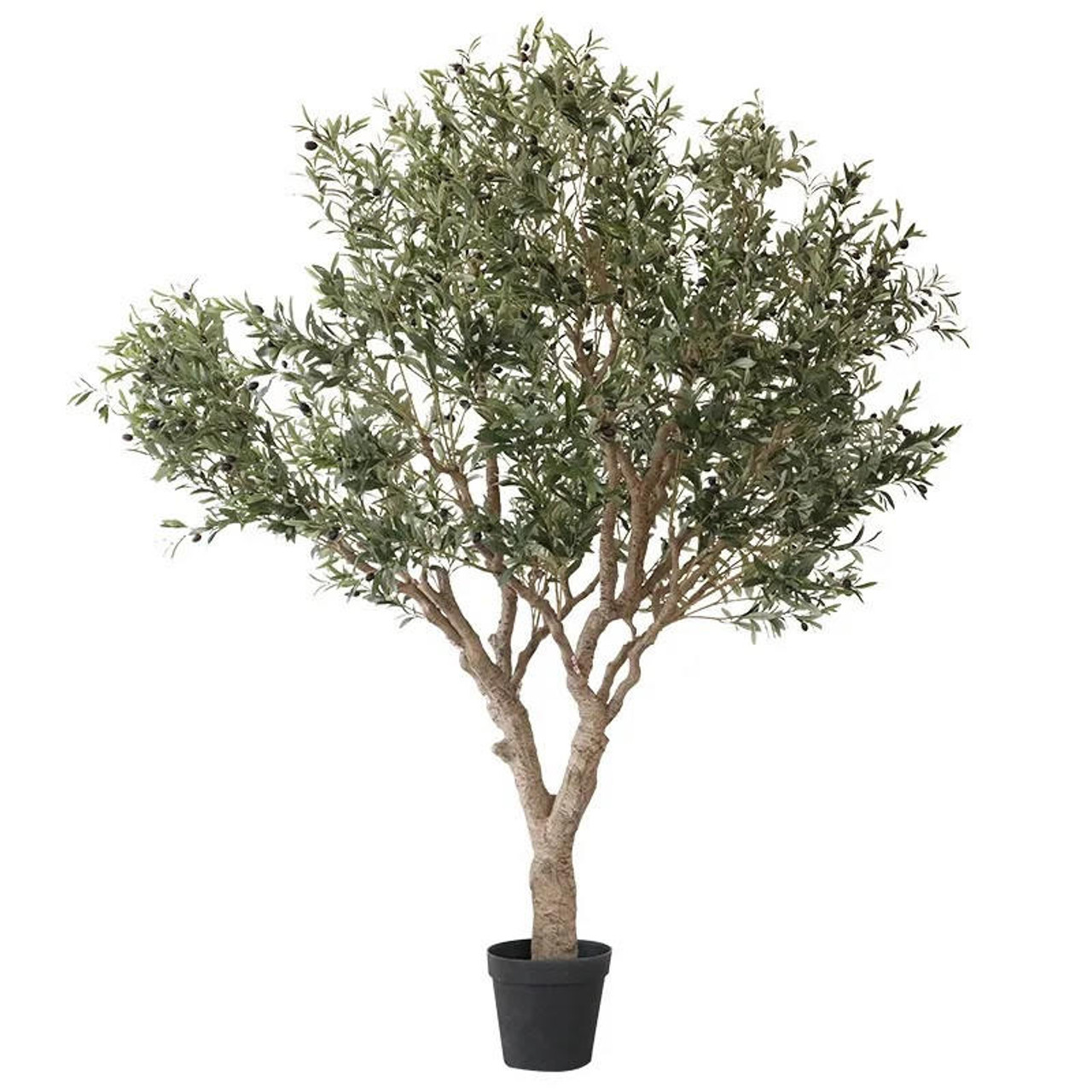The Olive Harvest: Traditional Techniques and Modern Innovations
10th Aug 2024
The Olive Harvest: Traditional Techniques and Modern Innovations
Ah, the olive harvest—a time when the Mediterranean countryside bursts into life with the scent of ripe olives, the hum of conversation, and the rhythmic thud of fruit hitting the ground. It's an ancient tradition steeped in history, culture, and yes, a bit of good old-fashioned hard work. But as with all things, the times they are a-changin'. While some still cling lovingly to the old ways, others are embracing the shiny new toys of modern technology. So, grab a cup of olive-leaf tea (or perhaps a glass of wine), and let's dive into the fascinating world of olive harvesting—where ancient meets modern, and tradition dances with innovation.
The Good Old Days: Traditional Olive Harvesting Techniques
Let’s start with the classics, shall we? Imagine a rustic Mediterranean landscape, sun-kissed hills dotted with gnarled olive trees, and a community coming together to gather the fruit of their labor. Traditional olive harvesting is as much about the people as it is about the olives. It’s a social event, a celebration, and sometimes, a bit of a competitive sport. So, how did they do it back in the day?
- Hand-Picking: The Original Slow Food Movement
Hand-picking olives is the OG of harvesting techniques, and it’s as simple as it sounds. With nothing more than their hands (and maybe a ladder), harvesters would pluck olives directly from the branches, one by one. It’s a painstaking process, but it’s gentle on the fruit, which is crucial if you’re going for the crème de la crème of olive oils—extra virgin. Hand-picking is still in use today, especially for premium olives destined for high-quality oil or table olives.
But let’s be real—it’s slow. We’re talking tortoise-racing-a-snail slow. And when you’ve got hectares of olive trees to harvest, time isn’t exactly on your side. But for those who appreciate the meditative rhythm and the connection to nature, hand-picking is more than a method—it’s a way of life.
- The Beating Heart of Tradition: The Olive Beater (aka "Bacchiatura")
If hand-picking is the gentle caress, then the olive beater is the slightly more assertive handshake. Bacchiatura, as it’s called in Italy, involves whacking the branches with long sticks (usually wooden or bamboo) to knock the olives off their perches. Harvesters spread nets under the trees to catch the falling fruit—a kind of olive trampoline, if you will.
It’s faster than hand-picking, but it’s also a bit more aggressive. There’s always the risk of damaging the branches or knocking off unripe olives, which could affect the quality of the oil. But hey, it’s great for working out those arm muscles, and there’s something deeply satisfying about giving a tree a good shake.
- Nets and Rakes: Catching Olives Like Fish
Sometimes, it’s not just about what’s above ground—there’s plenty of action happening down below too. Traditional harvesters often use nets spread out beneath the trees to catch olives that fall naturally or are coaxed down by rakes. The rakes, which are more like wide-toothed combs, are used to gently tease the olives from the branches, guiding them to their soft landing.
This method is a middle ground—less labor-intensive than hand-picking, but gentler than beating the branches. It’s also pretty ingenious, don’t you think? It’s as if the harvesters thought, “Why should we go up to the olives when we can just make them come to us?”
The Winds of Change: Modern Olive Harvesting Techniques
Fast forward to the 21st century, and the olive grove is no longer just the domain of farmers in straw hats and sturdy boots. Enter the age of technology, where the buzz of machinery joins the hum of nature. Modern olive harvesting techniques have introduced speed, efficiency, and a touch of sci-fi to the age-old practice. But is it all better? Or is there something lost in the transition? Let’s explore.
- Mechanical Shakers: Shake It Like a Polaroid Picture
Remember how I said the olive beater was great for working out those arm muscles? Well, what if you could let a machine do all the heavy lifting? Enter the mechanical shaker, a device that attaches to the trunk or branches of an olive tree and vibrates it vigorously, causing the olives to rain down into strategically placed nets or catchers.
Mechanical shakers are like the high-speed version of bacchiatura—efficient, effective, and capable of harvesting large areas in a fraction of the time. The downside? Well, it’s not exactly gentle. The shaking can be a bit too much for younger trees, and there’s always the risk of damaging the fruit. But when you’ve got thousands of trees to harvest and the clock is ticking, mechanical shakers are the way to go.
- Harvesting Machines: The Olive Combine
If the mechanical shaker is the modern-day olive beater, then harvesting machines are the combine harvesters of the olive world. These big, fancy machines drive through the rows of trees, using a combination of vibrating arms, rotating brushes, and conveyor belts to collect the olives. It’s like a giant olive vacuum cleaner—sucking up the fruit and leaving the trees mostly intact.
Harvesting machines are a game-changer for large-scale olive farms. They can cover massive areas in record time, drastically reducing the labor costs and the time needed to complete the harvest. But there’s a catch (isn’t there always?). These machines are big, expensive, and not always suitable for the varied and often hilly terrain of traditional olive groves. They’re best suited for super-intensive olive farming, where trees are planted in neat, uniform rows and pruned to accommodate the machinery.
- Drones and Sensors: The Sky’s the Limit
Okay, now we’re getting into the realm of futuristic farming. Drones and sensors are the latest buzzwords in precision agriculture, and the olive industry is no exception. Drones equipped with multispectral cameras can fly over olive groves, providing real-time data on tree health, moisture levels, and even the ripeness of the olives.
This technology allows farmers to monitor their groves with unprecedented accuracy, ensuring that they harvest at the optimal time and make better decisions about irrigation, fertilization, and pest control. It’s like having a bird’s-eye view of your entire operation, with the added bonus of looking really cool while doing it.
But drones and sensors are still relatively new to the olive scene, and they come with their own set of challenges—namely cost and the need for specialized knowledge to interpret the data. Still, they represent a significant leap forward in the way we think about and manage olive production.
The Great Debate: Tradition vs. Innovation
So, which is better—traditional techniques or modern innovations? As with most things in life, the answer isn’t black and white. Both approaches have their merits, and the best choice often depends on the specific circumstances of the olive farm.
The Case for Tradition: Traditional harvesting methods have stood the test of time for a reason. They’re gentle on the trees and the fruit, they preserve the integrity of the olives (essential for high-quality oil), and they’re deeply rooted in the cultural fabric of the Mediterranean. There’s also a certain romance to the traditional methods—a connection to the land and to the generations of farmers who have harvested olives before.
The Case for Innovation: On the other hand, modern techniques bring efficiency, scalability, and precision to the table. They’re indispensable for large-scale operations where time and labor costs are critical. Technology also allows for better resource management, reducing waste and optimizing production. For many farmers, embracing innovation isn’t just a choice—it’s a necessity in an increasingly competitive and globalized market.
But here’s the thing—these aren’t mutually exclusive paths. In fact, the most successful olive farms often blend the best of both worlds, using technology to enhance and support traditional practices. For example, a farm might use drones to monitor tree health but still rely on hand-picking or gentle mechanical shakers to harvest the olives. Or they might use modern processing techniques to ensure the highest quality oil while preserving the authenticity of their product.
The Future of Olive Harvesting: What Lies Ahead?
As we look to the future, it’s clear that technology will continue to play a significant role in the olive industry. But it’s equally clear that tradition will never be completely left behind. The olive tree is, after all, a symbol of endurance and resilience—qualities that are reflected in the people who cultivate it.
We might see even more advanced technologies entering the scene—robotic harvesters, AI-driven farm management systems, and who knows what else. But we’ll also see a continued appreciation for the artisanal, the authentic, and the hands-on approach that has defined olive harvesting for millennia.
In the end, the olive harvest will always be a blend of old and new, tradition and innovation. And whether you’re hand-picking olives in a sun-drenched grove or operating a high-tech harvester, one thing remains constant—the olive tree continues to give us its precious fruit, connecting us to a history that spans thousands of years and a future full of possibilities.
So next time you drizzle olive oil over your salad or dip a piece of bread into that golden liquid, take a moment to appreciate the journey it took to get there—a journey that bridges the ancient and the modern, the hands and the machines, the past and the future.





